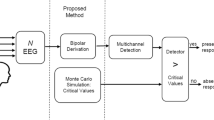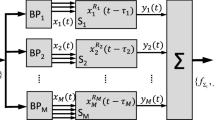Abstract
Auditory steady-state response (ASSR) is useful for hearing threshold estimation. The ASSR is usually detected with objective response detectors (ORD). The performance of these detectors depends on the signal-to-noise ratio (SNR) as well as the signal length. Since it is undesirable to increase the signal length, then, this work provides a multivariate technique for improving the SNR and consequently the detection power. We propose the insertion of a short calibration step before the detection protocol, in order to perform a search among the available electroencephalogram (EEG) derivations and select the derivation with the highest SNR. The ORD used in this work was the magnitude-squared coherence (MSC). The standard detection protocol is to use the same EEG derivation in all exams. Using 22-scalp positions, the new technique achieved a detection rate higher than that obtained in 99.13% of the standard detection protocol. When restrictions were applied to the search, a superior performance was achieved. Thus, the technique proposed was able to track the best EEG derivations before exams and seems to be able to deal with the variability between individuals and between sessions.
Graphical abstract








Similar content being viewed by others
References
Picton TW, John MS, Dimitrijevic A, Purcell D (2003) Human auditory steady-state responses: respuestas auditivas de estado estable en humanos. Int J Audiol 42(4):177–219
van der Reijden CS, Mens LH, Snik AF (2004) Signal-to-noise ratios of the auditory steady-state response from fifty-five EEG derivations in adults. J Am Acad Audiol 15(10):692–701
van der Reijden CS, Mens LH, Snik AF (2005) EEG derivations providing auditory steady-state responses with high signal-to-noise ratios in infants. Ear Hear 26(3):299–309
Wilding T, McKay C, Baker R, Kluk K (2012) Auditory steady state responses in normal-hearing and hearing-impaired adults: an analysis of between-session amplitude and latency repeatability, test time, and F ratio detection paradigms. Ear Hear 33(2):267–278
Dimitrijevic A, John SM, Van Roon P, Purcell DW, Adamonis J, Ostroff J, Picton TW (2002) Estimating the audiogram using multiple auditory steady-state responses. J Am Acad Audiol 13(4):205–224
Van Maanen A, Stapells DR (2005) Comparison of multiple Auditory Steady-State Responses (80 versus 40 Hz) and slow cortical potentials for threshold estimation in hearing-impaired adults: comparación de las respuestas auditivas múltiples de estado estable (80 vs 40 Hz) y de los potenciales corticales lentos en la estimación de umbrales en adultos con hipoacusia. Int J Audiol 44(11):613–624
Hatzopoulos S, Prosser S, Ciorba A, Giarbini N, Kochanek K, Sliwa L et al (2009) Threshold estimation in adult normal-and impaired-hearing subjects using auditory steady-state responses. Med Sci Monit 16(1):CR21–CR27
D’Haenens W, Vinck BM, Maes L, Bockstael A, Keppler H, Philips B, Dhooge I (2010) Determination and evaluation of clinically efficient stopping criteria for the multiple auditory steady-state response technique. Clin Neurophysiol 121(8):1267–1278
Rosner T, Kandzia F, Oswald JA, Janssen T (2011) Hearing threshold estimation using concurrent measurement of distortion product otoacoustic emissions and auditory steady-state responses. J Acoust Soc Am 129(2):840–851
Hatzopoulos S, Petruccelli J, Œliwa L, Jędrzejczak WW, Kochanek K, Skarżyński H (2012) Hearing threshold prediction with auditory steady state responses and estimation of correction functions to compensate for differences with behavioral data, in adult subjects: part 1: Audera and CHARTR EP devices. Med Sci Monit 18(7):MT47–MT53
Mühler R, Mentzel K, Verhey J (2012) Fast hearing-threshold estimation using multiple auditory steady-state responses with narrow-band chirps and adaptive stimulus patterns. Sci World J 2012:1–7
Attias J, Karawani H, Shemesh R, Nageris B (2014) Predicting hearing thresholds in occupational noise-induced hearing loss by auditory steady state responses. Ear Hear 35(3):330–338
Lee MY, Ahn SY, Lee HJ, Jung JY, Rhee CK, Suh MW (2016) Narrow band CE-Chirp auditory steady-state response is more reliable than the conventional ASSR in predicting the behavioral hearing threshold. Auris Nasus Larynx 43(3):259–268
Bakhos D, Vitaux H, Villeneuve A, Kim S, Lescanne E, Pigeon V, Galvin J (2016) The effect of the transducers on paediatric thresholds estimated with auditory steady-state responses. Eur Arch Otorhinolaryngol 273(8):2019–2026
Casey KA, Small SA (2014) Comparisons of auditory steady state response and behavioral air conduction and bone conduction thresholds for infants and adults with normal hearing. Ear Hear 35(4):423–439
Hosseinabadi R, Jafarzadeh S (2015) Auditory steady-state response thresholds in adults with conductive and mild to moderate sensorineural hearing loss. Iran Red Crescent Med J 17(1). https://doi.org/10.5812/ircmj.18029.
Israelsson KE, Bogo R, Berninger E (2015) Reliability in hearing threshold prediction in normal-hearing and hearing-impaired participants using mixed multiple ASSR. J Am Acad Audiol 26(3):299–310
Sardari S, Jafari Z, Haghani H, Talebi H (2015) Hearing aid validation based on 40 Hz auditory steady-state response thresholds. Hear Res 330:134–141
Seidel DU, Flemming TA, Park JJH, Remmert S (2015) Hearing threshold estimation by auditory steady-state responses with narrow-band chirps and adaptive stimulus patterns: implementation in clinical routine. Eur Arch Otorhinolaryngol 272(1):51–59
Zakaria MN, Jalaei B, Wahab NAA (2016) Gender and modulation frequency effects on auditory steady state response (ASSR) thresholds. Eur Arch Otorhinolaryngol 273(2):349–354
Maeda H, Tamashige E, Iwasaki N, Urano D, Kanazawa A (2017) Evaluation of hearing sensitivity in young adults with normal hearing using a 40-hz auditory steady-state response with CE-Chirp. Am J Audiol 26(2):99–109
Herdman AT, Lins O, Van Roon P, Stapells DR, Scherg M, Picton TW (2002) Intracerebral sources of human auditory steady-state responses. Brain Topogr 15(2):69–86
De Sá AM, Infantosi AFC, Simpson DM (2002) Coherence between one random and one periodic signal for measuring the strength of responses in the electro-encephalogram during sensory stimulation. Med Biol Eng Comput 40(1):99–104
Felix LB, Antunes F, da Silva Carvalho JA, dos Santos Barroso MF (2018) Comparison of univariate and multivariate magnitude-squared coherences in the detection of human 40-Hz auditory steady-state evoked responses. Biomed Signal Process Control 40:234–239
Eloi BFS, Antunes F, Felix LB (2018) Improving the detection of auditory steady-state responses near 80 Hz using multiple magnitude-squared coherence and multichannel electroencephalogram. Biomed Signal Process Control 42:158–161
Silva GM, Antunes F, Henrique CS, Felix LB (2018) Assessment of auditory threshold using multiple magnitude-squared coherence and amplitude modulated tones monaural stimulation around 40 Hz. Comput Methods Prog Biomed 159:71–76
Dobie RA, Wilson MJ (1989) Analysis of auditory evoked potentials by magnitude-squared coherence. Ear Hear 10(1):2–13
Miranda de Sá AMFL (2006) A note on the coherence-based signal-to-noise ratio estimation in systems with periodic inputs. J Franklin Inst 343(7):688–698
Xi J, Chicharo JF (1996) A new algorithm for improving the accuracy of periodic signal analysis. IEEE Trans Instrum Meas 45(4):827–831
Miranda de Sá AMFL, Infantosi AFC (2002) A coherence-based technique for evaluating the degree of synchronism in the EEG during sensory stimulation. Rev Bras Eng Biomed 18:39–49
Funding
This work was supported by the Brazilian Agencies: CNPq, FAPEMIG, and CAPES. It was also in part developed in the University of Southampton.
Author information
Authors and Affiliations
Corresponding author
Ethics declarations
Ethical approval
This work is approved by the Local Ethics Committee. (UFV/ CAAE: 56346916.4.0000.5153).
Conflict of interest
The authors declare no competing interests.
Additional information
Publisher’s note
Springer Nature remains neutral with regard to jurisdictional claims in published maps and institutional affiliations.
Rights and permissions
About this article
Cite this article
Antunes, F., Zanotelli, T., Simpson, D.M. et al. Multichannel search strategy for improving the detection of auditory steady-state response. Med Biol Eng Comput 59, 391–399 (2021). https://doi.org/10.1007/s11517-021-02323-z
Received:
Accepted:
Published:
Issue Date:
DOI: https://doi.org/10.1007/s11517-021-02323-z




